

|
MAPA HISTORICO © 2014 Kiwanis Club of Taos |
 |
|
|
Taos offers visitors a refreshing change from a world of speed, confusion and stress. Friendly inhabitants, a touch of the frontier (although it was one of the first European settlements in the United States, established soon after 1500), a temperate climate, a splendid natural setting, diverse recreational and cultural activities - all these make Taos one of the premiere vacation destinations in the West. The nearby forested mountains abound in game: deer, elk, bear and wild turkey. Seasonal trout fishing is outstanding in mountain lakes and streams and year-round in the Rio Grande. Try horseback riding through valleys surrounded by snow-capped peaks. Consider, a raft rip down the Rio Grande River. Skiing and snowboarding may be enjoyed at several nearby resorts from Thanksgiving to Easter - Taos Ski Valley, Red River, Angel Fire and Sipapu. Taos offers fine lodging and excellent restaurants. Dozes of art galleries display works of resident artists, many of whom are nationally known. Stores offer Southwestern Indian handcrafts, striking locally handcrafted gift items and - for the admirer of wearing apparel - popular Taos Fiesta dresses. The new remodeled Taos Community Auditorium is summer-long center of music and theater. The New Mexico Music Festival at Taos offers frequent concerts and the Taos School of Music is noted for its chamber music performances. Spring and Fall brings the Taos Spring Arts Festival (April/May) and later in the season, (September/October) heralds the arrival of the Taos Fall Arts Festival - truly world-class arts and crafts for all lovers of beauty. Whether you're in Taos during one of the above events, or the Fiestas de Taos, fourth weekend in July, the San Geronimo festival at Taos Pueblo in late September, or any other day of the year, the past will come alive. Time loses its meaning as you get to know this community of three cultures: Indian, Spanish and Anglo-American, in order of arrival date. This combination produces the "Taoseño," (pronounce it Taos (rhymes with house)-EN-yo) which are people whose special delight is to take time to live fully and naturally in a hurry-up world. The past is ever-present in the names of business and professional people of Taos, descendants of the Conquistadores, Native Americans, the French fur-traders and American pioneers famous in history. The Village of Fernandez de Taos, as it was first called, was established as the northern-most outpost of New Spain about 1615, preceding the Pilgrims' landing at Plymouth Rock by 5 years. The peaceful Indian village neighboring Taos to the north offered the European settlers water for their homes and farms, in exchange for a mutual pact of defense against marauding Navajo, Ute and other tribes. Life Taos Valley was relatively tranquil until the great Pueblo Rebellion of 1680. All the settlers were expelled by the Indians, returning peacefully about 1692 under the leadership of Don Diego de Vargas. For the next hundred years Taos became a haven of Spanish culture with a self-sufficient agricultural and trading economy. During this period, before the American Revolution, the notable mission church at Ranchos de Taos was build. A few years later the Trampas and Truchas missions were established. These churches, with their carved and painted altars and Santos, today are greatly admired and much photographed examples of Southwest Architecture. By 1754, the great Taos trade fairs came into their own. Goods were brought by mule train from as far south as Chihuahua, Mexico. Taos became a hub in the world of bartering and selling among Indians, colonists, French fur traders and American "mountain men." These yearly gatherings afforded trappers and traders an opportunity to enjoy a rare measure of civilization. Once their earnings were exhausted, the visitors would return to the wild country and months of loneliness. Taos was know as a land of fun and merriment where all cold dance, drink, eat and make merry - even as today. As a result of Mexico's independence fro Spain in 1921, the flag of Spain ceased to fly over Taos, and for 26 years the region was under the rule of Mexico. The U.S. occupation in 1846, although welcomed at first as a hopeful sign of better and more efficient administration that had been experienced from far off Mexico, soon proved a bitter disappointment to the inhabitants. Following was a tragic period of turmoil and exploitation by the "new masters," as hordes of adventurers used the strange new court system as a cloak for land grabbing and for fomenting excesses against established customs. As incidents mounted, the atmosphere heated by trigger-happy elements, rebellion became inevitable. When it started, one of the victims was the territory's first governor, Charles Bent (see below). The rebellion was suppressed soon, however, by U.S. cavalry and artillery sent from the capital in Santa Fe. Missed by the railroad, reached only by poor roads that discouraged contact with the outside world, Taos settled down finally to the peace and quiet of the rural life disturbed somewhat only in 1877 by feverish mining activity in the Twining (now Taos Ski Valley) area. |
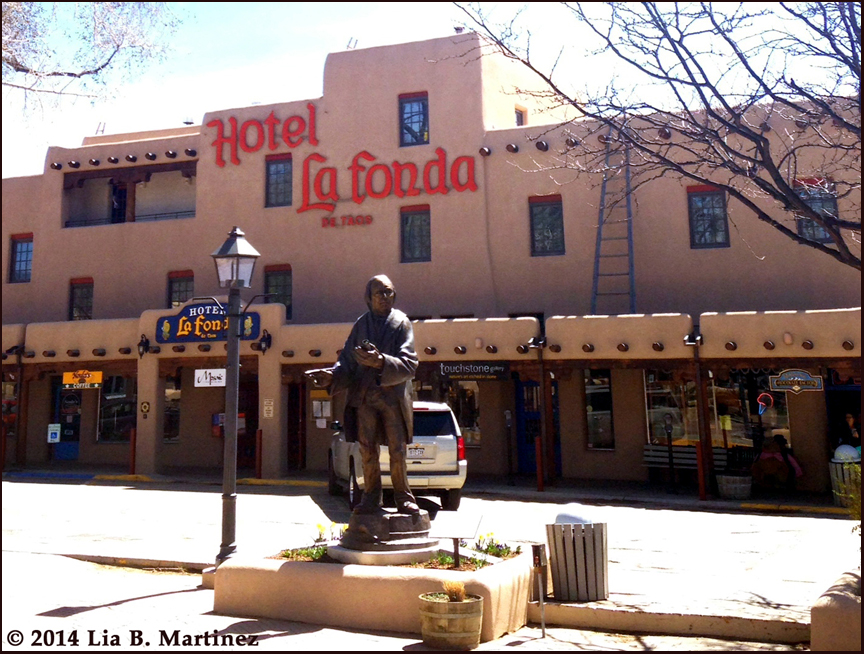 |
|
|
|
The natural beauty and the rich cultures of Taos account for its fame as an art colony, dating from the 1890's. Actually, a broken wagon wheel led two young artists, Bert G. Phillips and Ernest Blumenshein, traveling south from Colorado, to spend some time in Taos while awaiting repairs. They were so impressed by the surroundings, the people and their philosophy of life, that they stopped their journey and in succeeding years, brought other artists to form the nucleus of the Taos art colony. The Blumenshein Home is located on Ledoux Street, two blocks from Taos Plaza. It houses exhibits on the Taos Artists. |
|
HOME & MUSEUM 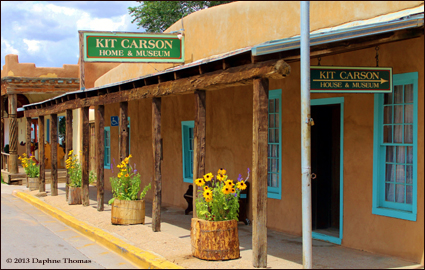 |
In 1826, at the age of 16, Kit Carson ran away from home in Missouri to come to Taos, a key center for the mountain men. Taos was to be his headquarters, and later home, until his death in 1868. Carson led a colorful life as trapper, hunter, scout and guide, rancher, Indian agent, soldier and family man. Though Carson was the West's most famous scout, many of his other activities were important in building the Western United States. His loyalty to country was unshakable. His home, built in 1825, was bought by Kit in 1843 when he married Josefa Jaramillo, member of a prominent Spanish family of Taos. It was their permanent residence for the next 25 years, their lifetime together. Seven of their eight children were born in this historic Taos landmark. |
|
Charles Bent was a highly respected, much loved figure of the Old West. He was a trader and owner of wagon trains on the Santa Fe Trail. He owned trading post in Santa Fe and Taos and dealt with early mountain men. He provided them with supplies and bought their furs and buffalo hides. He, his brother William and Ceran St. Vrain built Bent's Fort in Colorado - famous throughout the West as a Trading center for Indians and mountain men. He was appointed Governor of New Mexico in 1846 when it was annexed by the United States during the Mexican War. In January of 1847, he was killed in his home by an angry mob, which was protesting U.S. rule. Today a museum, open to the public is housed in the old adobe home - the Governor Bent House. It is located one block north of the Plaza and a half-block west of the Taos Inn on Bent Street. |
|
HACIENDA 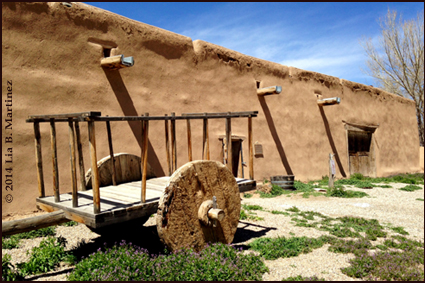 |
|
|
Son of the founder of the Martinez Hacienda, no other single individual contributed so aredently and in such broad scope to the development of Northern New Mexico as did Padre Martinez. A man of vision, always thirsting for progress, he played an important role culturally and politically during the years of transition after 1826 and until his death in 1867. He established the first co-educational school west of the Mississippi. He published the Southwest's first newspaper, called "El Crepusculo de la Libertad," in Taos. He edited and printed his own school books. He presided over the First Territorial Assembly in 1832, recognizing the need for better understanding between his people and the Americans. Conflict with church and state was part of this life, too, but death found him helping and guiding his people in adjusting to American laws and customs. |
|
Turley's Mill -- The extensive ruined rock walls of this notable landmark (now closed to the public) stand in the Rio Hondo Valley, a monument to the first industrial product, originally know as "Aguardiente" and later as "Taos Lightning" utilized in its manufacture all of the surplus grain raised in the Taos Valley, and provided a sizable source of revenue to the ranchers of the valley for many years prior to the American occupation. While the exact date of the establishment is unknown, the distilled Taos product is referred to in the earliest diaries of French trappers who operated in the West as early as 1740. Taos Lightning
was exported by pack mule into the far reaches of the West, first
in skin containers and later in kegs, by French trappers and
later by the Mountain Men, to be traded to Indians for beaver
pelts, tanned skins and whatever the Indians had to barter. No
"biale" or "siesta" in New Mexico was complete
without the serving of liberal portions of Aguardiente. The distillery
was destroyed during the uprising |
|
MUSEUM 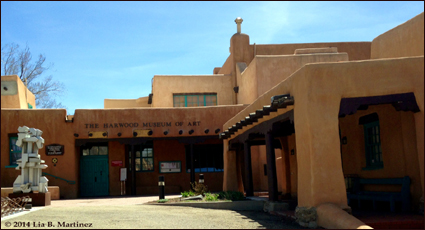 Today, the Museum exhibits its
permanent Today, the Museum exhibits its
permanentcollection with ten changing exhibits annually. |
For over eighty years the Harwood Museum of Art of the University of New Mexico has maintained a unique record of northern New Mexico's rich multicultural heritage and Taos' role in the development of American art. The historic adobe compound - portions of which date to the mid-19th Century - has been a landmark since Burt and Elizabeth Harwood bought the property in 1916 and developed it as one of the first examples of Pueblo Revival Architecture. In 1923, Mrs. Harwood and a group of Taos artists established the Harwood Foundation as a nonprofit organization to serve as an educational/cultural center. In 1997, the Harwood underwent a major renovation and expansion project transforming 11,000 square feet of the building into seven new galleries. |
|
Just three miles north of Taos is the famous "apartment house" home of the Taos Indians, first visited by Captain Hernandez de Alvarado of the Coronado expedition more than 400 years ago. He found the Pueblo, a thriving community of farmers and hunters, living in two great adobe buildings. These massive 5-story structures were combined apartments and fortresses and already were hundreds of years old. Their appearance undoubtedly has changed but little today; only doors and windows in the lower rooms have been added. Electricity is forbidden. (Originally, access was gained by ladders, which could be drawn up for protection.) In his report, Captain Alvarado stated that the Indians had a high form of culture, a well-organized system of government, and were masters of the art of irrigation from the stream that now divides the village. They raised corn, squash and beans, crops that are still cultivated. The ruined church at the northwest corner was constructed between 1610 and 1612, a few years after Father Zamora, a Franciscan, had organized a mission at the Pueblo. The church was destroyed by cannon fire during the 1847 rebellion and was never rebuilt. The Taos Indians historically have been self-supporting, and are leaders among Rio Grande pueblos in maintaining their tribal traditions. They have been successful in recent years in obtaining 40,000 additional acres for their reservation after they proved to Congress the land was improperly included in the neighboring Carson National Forest when it was designated soon after the turn of the century. Visitors are welcome at the Pueblo. A small fee may be charged for parking, and except on religious occasions, permission to take photographs my be obtained from the office of the Pueblo Governor - a fee is charged. The income is used to help operate tribal government and for community activities. |
|
DE ASIS CHURCH 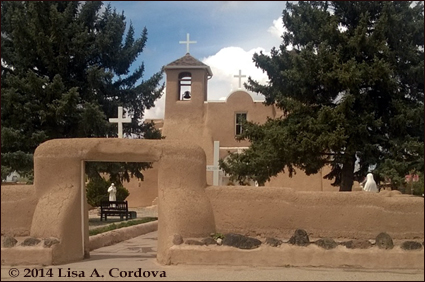 |
|
|
Taos, with its rare beauty, historical significance and cultural richness, brings visitors back year after year. It seems no one visits Taos just once. We look forward to your next visit and after publishing our map for 53 years, you'll find it again on your next visit. Enjoy your stay as Taos has marvelous things to see, fun things to do and great people with whom to converse! All profits from the map are given back to the children of our community through various organizations our club supports. ©
2014 Kiwanis Club of Taos |
|
|
|
|